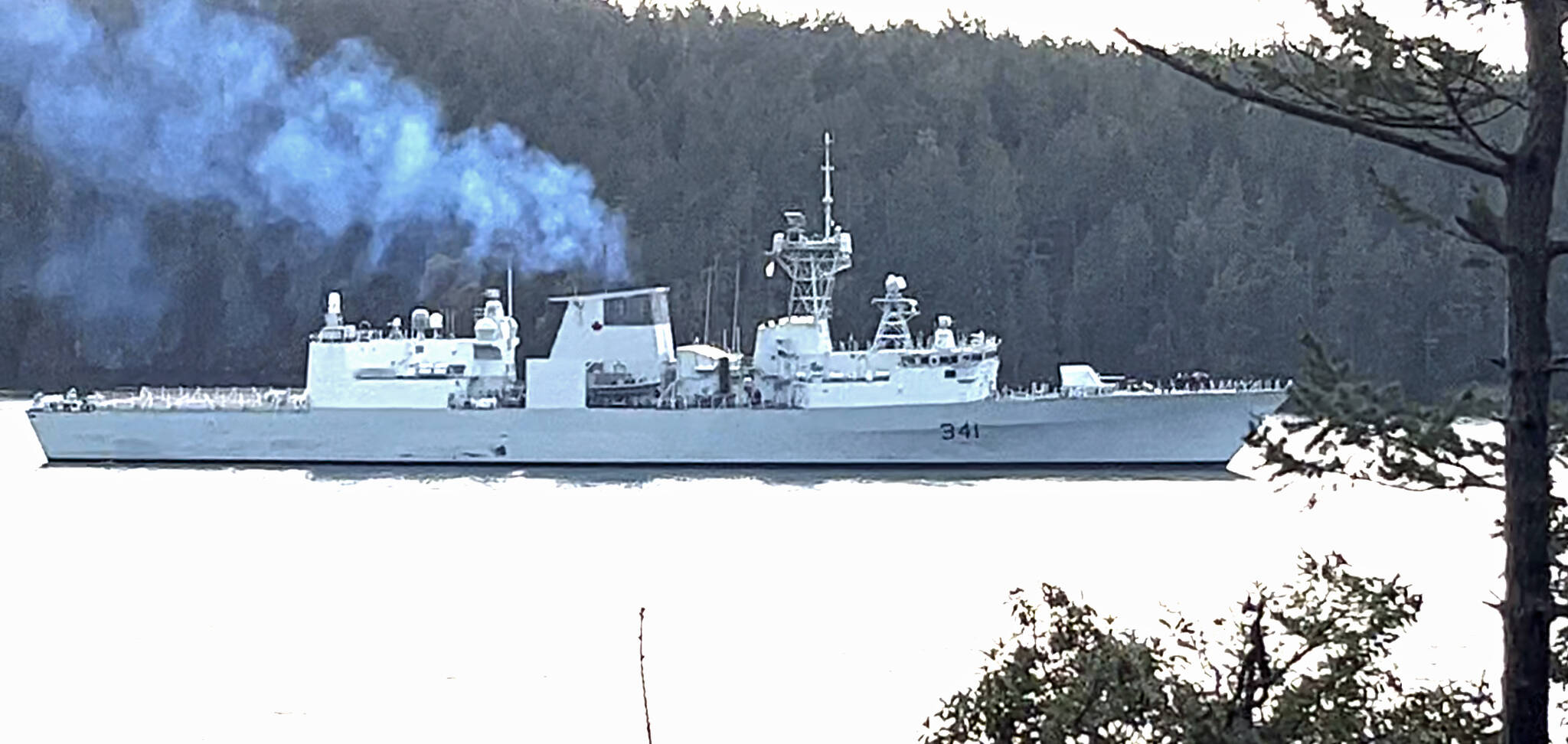by Toby Cooper
Special to the Sounder
The visual impact alone was extraordinary.
As the Yakima’s passengers awaited the ferry’’s midday departure from Orcas Landing, a prodigious grey hull cleared the point across from Shaw Island’s dock. Sleek, potent and maybe a tiny bit menacing, the 442-foot HMCS Ottawa looked every bit the part of a purposeful military frigate steaming through sleepy Cayou Channel. Trailing behind the ship was a thick plume of “blue smoke” pouring from its stacks.
It was one of those sights that fosters spontaneous conversations between complete strangers. Is this normal? It’s the Canadian Navy, right? Ken Carrasco, just up the channel, reached for his phone camera.
“It looks like they are running very rich,” said Carrasco, whose career included service on US Coast Guard ships not unlike the Ottawa, adding that the age of the engine may also be a factor. It could also mean the ship is burning low-quality fuel.
“But isn’t this regulated?” they asked on the Yakima.
Lovel Pratt, Marine Protection and Policy Director at Friends of the San Juans, explained that the International Maritime Organization, a London-based branch of the United Nations, maintains a comprehensive, worldwide regulatory framework over shipping, including environmental concerns.
Kendra Smith, Director of the San Juan County Department of Environmental Stewardship, stated her preference that “all vessels, regardless of ownership, transition to cleaner fuel sources,” and noted that the US Coast Guard has statutory authority over environmental quality in the waters of the US.
Pratt agreed, adding that, “Friends of the San Juans is very concerned about this apparent pollution,” and planned to reach out to the U.S. Coast Guard and other agencies with appropriate jurisdiction.
Known as a Halifax-class frigate, the HMCS Ottawa was launched in 1996 as the 12th and last such vessel in the Royal Canadian Navy. Halifax frigates are tasked and equipped for helicopter-assisted anti-submarine warfare.
On that Saturday, Dec. 3, according to a ship-tracking cellular app, the Ottawa left Anacortes in the morning, transited Rosario Straits, entered the San Juans through Thatcher Pass, proceeded up Cayou Channel, then turned right into West Sound. The ship did a 180 in front of the Orcas Island Yacht Club, then came back through Cayou, around Shaw and up President’s Channel and went inside Jones Island and did another 180 off Spring Point. The ship then returned to Canadian waters.
This meandering tour was part of regular Canadian Navy training exercises, according to Capt. Chelsie Dubeau of RCN public affairs.
The commander of the Ottawa did not respond by press time.
Officially, the Royal Canadian Navy is welcome in our waters, but if their ships leave a trail of pollution, concerns remain.
“We welcome many ships to our waters, including vessels from the RCN,” said Councilmember Cindy Wolf of Orcas. “It is my hope that all our visitors will participate as partners in safeguarding the health and safety of the Salish Sea by properly caring for their equipment and following practices that create the least amount of environmental damage possible.”
Petty Officer Michael Clark of the U.S. Coast Guard sees the Ottawa as operating “in accordance with applicable laws and regulations” and, choosing his words carefully, saw no reason to believe their tour resulted in any “illicit” impact on the environment.
Clark noted that under MARPOL 73 Article 3(3) of the International Convention for the Prevention of Pollution from Ships, the HMCS Ottawa is not a “signatory,” and thus falls under Article 3(3) which states, “The present convention shall not apply to any warship, naval auxiliary or other ship owned or operated by a State …”



